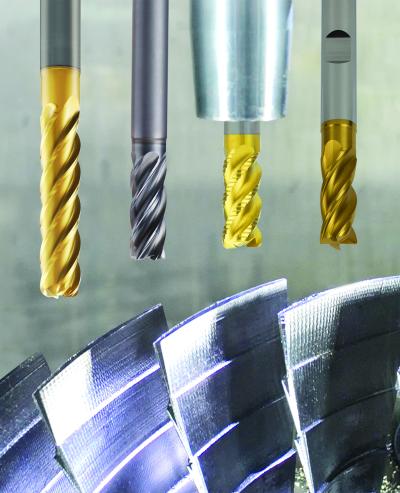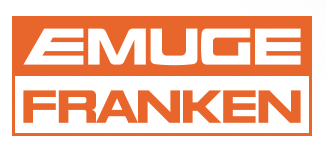
The TiNox-Cut VAR end mills line from EMUGE-FRANKEN USA are application-specific for the machining of tough materials from stainless steel and titanium to Inconel and nickel alloys and other challenging applications, the company says. The high-performance VAR end mills line -- with VAR an acronym for versatile, American-made and reliable performance -- is offered in four end mill types for semi-roughing and finishing applications:
- TiNox-Cut VAR-NF end mills are roughing tools for all materials that are difficult to machine, and are very efficient in Inconel and titanium. A fine chip breaker reduces chip size and cutting forces.
- TiNox-Cut VAR-N are tools specially designed for the machining of titanium and titanium alloys. They feature five flutes for high feed rates and have a raised land that increases chip clearance. The end mills are also available in standard corner radius types.
- TiNox-Cut VAR Base are entry-level universal roughing and finishing tools for the machining of stainless and acid-resistant steels.
- TiNox-Cut VAR Trochoidal offers a high metal removal rate (even on low-powered machines), reducing the stress and vibration for difficult materials and thin-walled components. Trochoidal milling is the overlapping of a circular path with a linear movement, converting slot milling into contour milling.
TiNox-Cut VAR End Mills are made from premium sub-micron grade solid carbide with a maximized transverse rupture strength. The company says the tools have advanced PVD applied coatings for heat and wear resistance, and an axial internal coolant channel design offers maximum chip evacuation performance and chip cooling ability. The high-performance end mills line is available in 4 and 5-flute configurations, and the Trochoidal cutters also offer 7-flute designs in metric sizes. The end mills have a maximum 4XD length, and the Trochoidal cutters also have an extra-long 5XD length in its metric sizes. TiNox-Cut VAR End Mills include a total of 188 SKUs and are offered in diameters from 0.125" to 1" and also in Trochoidal metric sizes from 6 mm to 20 mm.
Contact Details
Related Glossary Terms
- alloys
alloys
Substances having metallic properties and being composed of two or more chemical elements of which at least one is a metal.
- chip clearance
chip clearance
In milling, the groove or space provided in the cutter body that allows chips to be formed by the inserts.
- clearance
clearance
Space provided behind a tool’s land or relief to prevent rubbing and subsequent premature deterioration of the tool. See land; relief.
- coolant
coolant
Fluid that reduces temperature buildup at the tool/workpiece interface during machining. Normally takes the form of a liquid such as soluble or chemical mixtures (semisynthetic, synthetic) but can be pressurized air or other gas. Because of water’s ability to absorb great quantities of heat, it is widely used as a coolant and vehicle for various cutting compounds, with the water-to-compound ratio varying with the machining task. See cutting fluid; semisynthetic cutting fluid; soluble-oil cutting fluid; synthetic cutting fluid.
- feed
feed
Rate of change of position of the tool as a whole, relative to the workpiece while cutting.
- flutes
flutes
Grooves and spaces in the body of a tool that permit chip removal from, and cutting-fluid application to, the point of cut.
- gang cutting ( milling)
gang cutting ( milling)
Machining with several cutters mounted on a single arbor, generally for simultaneous cutting.
- land
land
Part of the tool body that remains after the flutes are cut.
- milling
milling
Machining operation in which metal or other material is removed by applying power to a rotating cutter. In vertical milling, the cutting tool is mounted vertically on the spindle. In horizontal milling, the cutting tool is mounted horizontally, either directly on the spindle or on an arbor. Horizontal milling is further broken down into conventional milling, where the cutter rotates opposite the direction of feed, or “up” into the workpiece; and climb milling, where the cutter rotates in the direction of feed, or “down” into the workpiece. Milling operations include plane or surface milling, endmilling, facemilling, angle milling, form milling and profiling.
- milling machine ( mill)
milling machine ( mill)
Runs endmills and arbor-mounted milling cutters. Features include a head with a spindle that drives the cutters; a column, knee and table that provide motion in the three Cartesian axes; and a base that supports the components and houses the cutting-fluid pump and reservoir. The work is mounted on the table and fed into the rotating cutter or endmill to accomplish the milling steps; vertical milling machines also feed endmills into the work by means of a spindle-mounted quill. Models range from small manual machines to big bed-type and duplex mills. All take one of three basic forms: vertical, horizontal or convertible horizontal/vertical. Vertical machines may be knee-type (the table is mounted on a knee that can be elevated) or bed-type (the table is securely supported and only moves horizontally). In general, horizontal machines are bigger and more powerful, while vertical machines are lighter but more versatile and easier to set up and operate.
- physical vapor deposition ( PVD)
physical vapor deposition ( PVD)
Tool-coating process performed at low temperature (500° C), compared to chemical vapor deposition (1,000° C). Employs electric field to generate necessary heat for depositing coating on a tool’s surface. See CVD, chemical vapor deposition.
- wear resistance
wear resistance
Ability of the tool to withstand stresses that cause it to wear during cutting; an attribute linked to alloy composition, base material, thermal conditions, type of tooling and operation and other variables.

